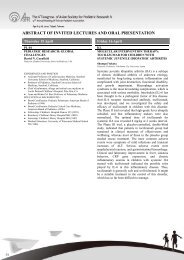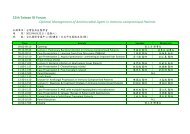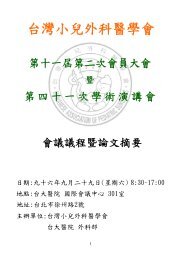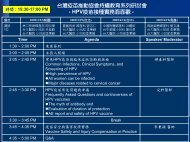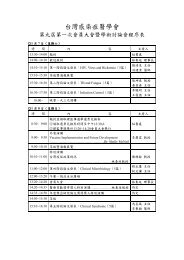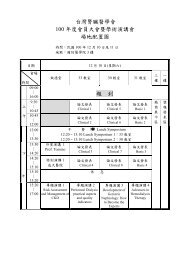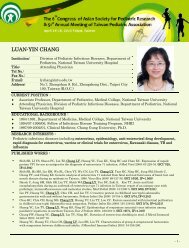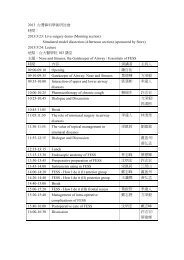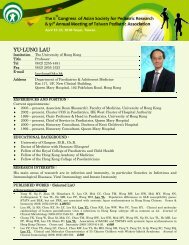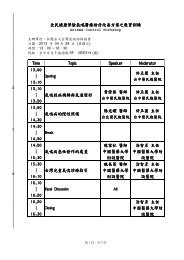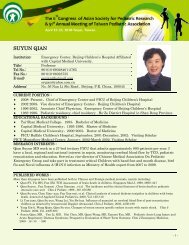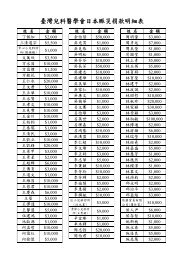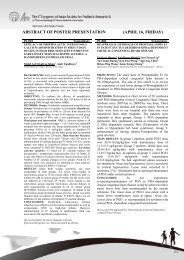ABSTRACT OF POSTER PRESENTATION (APRIL 17, SATURDAY)
ABSTRACT OF POSTER PRESENTATION (APRIL 17, SATURDAY)
ABSTRACT OF POSTER PRESENTATION (APRIL 17, SATURDAY)
Create successful ePaper yourself
Turn your PDF publications into a flip-book with our unique Google optimized e-Paper software.
P2-003 Allergy/Immunology/Rheumatology P2-004 Allergy/Immunology/RheumatologyHIGH MOBILITY GROUP BOX 1 (HMGB1)AND MACROPHAGE MIGRATIONINHIBITORY FACTOR (MIF) IN KAWASAKIDISEASETHE EFFECT <strong>OF</strong> FK506 ONSUPERANTIGEN-INDUCED STEROIDRESISTANCE <strong>OF</strong> CUTANEOUSLYMPHOCYTE-ASSOCIATED ANTIGEN CD4 TCELLSTakayuki Hoshina 1 , Koichi Kusuhara 2 , KazuyukiIkeda 3 , Mitsumasa Saito 4 , Toshiro Hara 5Pediatrics, Graduate School of Medical Sciences, Kyushu University 1 ,Department of Pediatrics, University of Occupational and EnvironmentalMedicine 2 , Department of Pediatrics, Graduate School of MedicalSciences 3 , Pediatrics, Kyushu university 4 , Department of Pediatrics,Graduate School of Medical Sciences, Kyushu University, Japan 5Liang-Shiou Ou, Jing-Long HuangDivision of Allergy, Asthma and Rheumatology, Department of Pediatrics, ChangGung Memorial Hospital, and Chang Gung University, Taoyuan, Taiwan.OBJECTIVE: To investigate whether twoproinflammatory cytokines, high mobility group box1 (HMGB1) and macrophage migration inhibitoryfactor (MIF) are involved in the development ofKawasaki Disease (KD).METHODS: Twenty-seven patients with KD wereincluded in this study. Eleven patients with sepsisand 28 healthy children served as controls. Serumlevels of HMGB1 and MIF were measured bycorresponding enzyme-linked immunosorbent assaykits, respectively. Real-time polymerase chainreaction was used to quantify the expression levels ofgenes encoding receptor for advanced glycation endproducts (RAGE), an HMGB1 receptor and CD74,an MIF receptor in peripheral blood mononuclearcells.RESULTS: Serum levels of HMGB1 and MIF inKD patients were the highest in the early acute phaseand gradually decreased after defervescence. SerumHMGB1 and MIF levels in KD patients weresignificantly higher than those in controls (HMGB1,P< 0.001; MIF, P< 0.01). The expression levels ofthe RAGE gene and CD74 gene in KD patients weresignificantly higher than those in controls (RAGE,P< 0.001; CD74, P< 0.01).CONCLUSIONS: These data suggest that HMGB1and MIF play an important role in immune responsesin KD patients.[Keywords]Kawasaki disease, High mobility group box-1,Macrophage migration inhibitory factor, Receptor for advancedglycation end products, CD74OBJECTIVE: Atopic dermatitis is a chronicinflammatory skin disease involving colonization bysuperantigen secreting Staphylococcus aureus.Superantigens are thought to play an important role ininducing inflammatory responses. This study is todetermine the effect of FK506 on superantigen-inducedsteroid resistance of cutaneous lymphocyte-associatedantigen CD4 T cells.METHODS: CD4 + CLA + T cells were isolated bymagnetic microbeads and cell proliferation wasmeasured by [ 3 H]-thymidine incorporation with differentstimulators and suppressors. Flow cytometry for surfacemarkers were determined.MAIN RESULTS: The proliferation of purifiedCD4 + CLA + or CD4 + CLA - T cells with anti-CD3stimulation with presence the APCs were sensitive to theinhibition of dexamethasone (DEX). The inhibition ratesof 10 -6 M DEX were 78.4±20.1% for CD4 + CLA + cellsand 70.1 ± 19.4% CD4 + CLA - T cells. The proliferationof purified CD4 + CLA + or CD4 + CLA - T cells withstaphylococcal enterotoxin B (SEB), stimulation withpresence the APCs were insensitive to the inhibition ofDEX, and the inhibition rate of 10 -6 M DEX were39.6±33.0% and 37.6±43.3% for CD4 + CLA + andCD4 + CLA - T cells. Tacrolimus (FK506), however, washighly effective at inhibiting SEB-induced T cellactivation. SEB-induced CD4 + CLA + and CD4 + CLA - Tcells proliferation both were significantly suppressed byFK506 in the presence APCs. The inhibition rates of 10 -6M FK506 were 90.8 ± 20.0% and 88.5 ± 9.8% forCD4 + CLA + and CD4 + CLA - T cells.CONCLUSION: Superantigen can induce steroidresistance on CD4 + CLA + and CD4 + CLA - T cells withpresence of APCs. However, the suppressive function ofFK506 might revere superantigen- induced steroidresistance.256



